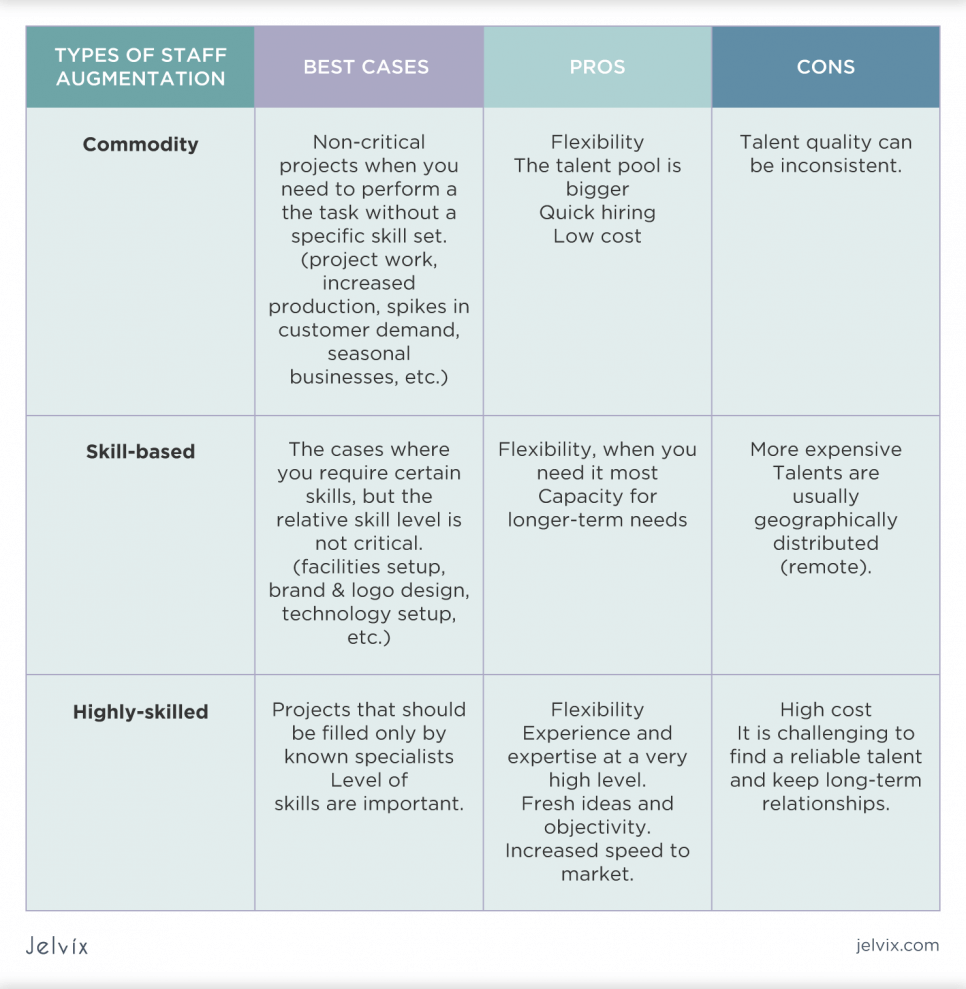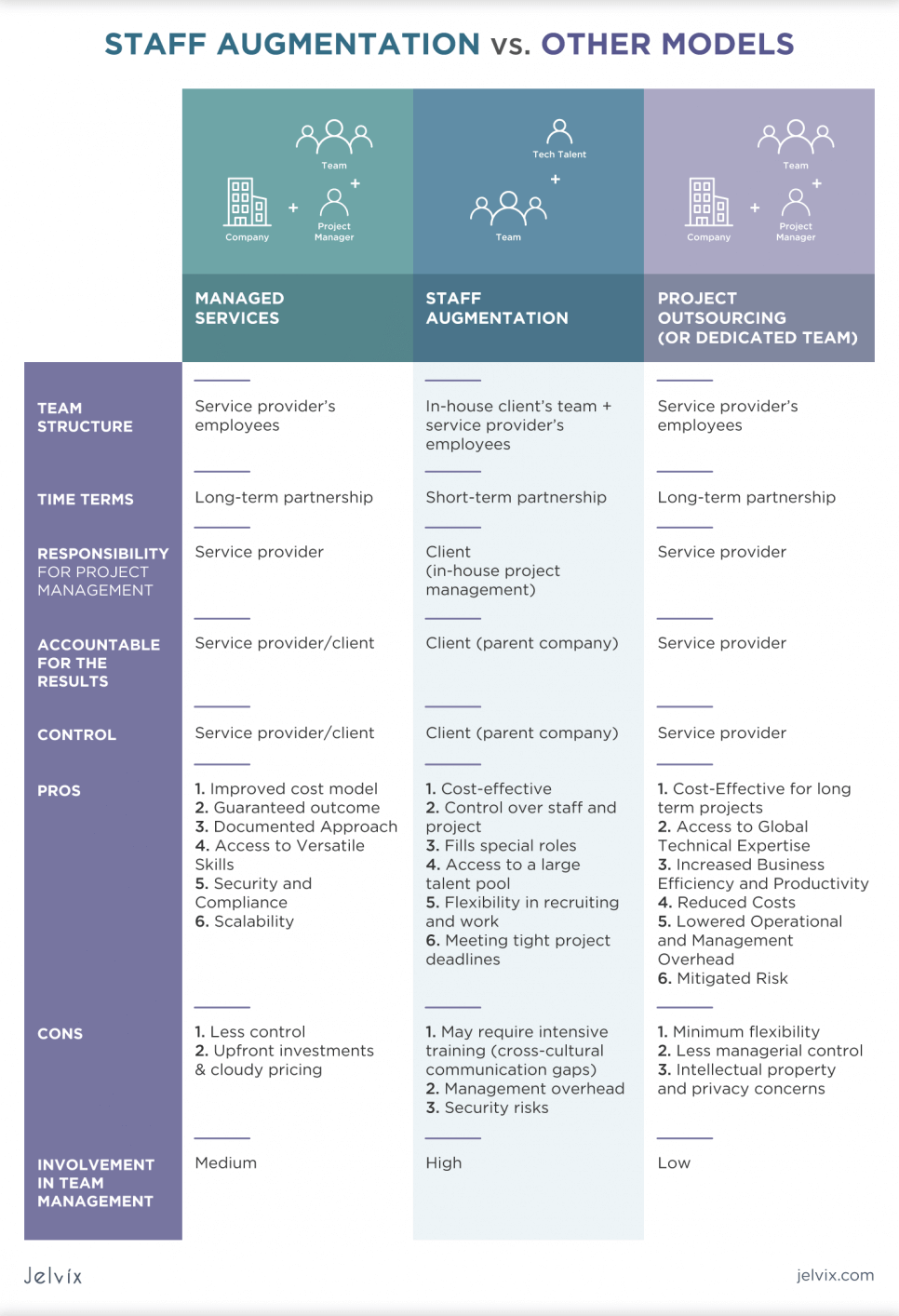Demand for expert IT services has long outstripped supply in a dynamic business environment. By 2030, the global talent gap will reach 85.2 million; therefore, it is becoming more and more difficult to find specialists with the skills, experience, and acceptable rates.
That’s why companies are looking for alternatives to traditional hiring in flexible staffing solutions, such as staff augmentation or managed services. This article is a must-read if you’ve ever wondered what staff augmentation is and how it differs from managed services. We will analyze the features of both models and help you understand their differences.
 What is a Staff Augmentation?
What is a Staff Augmentation?
Remote staff augmentation is a model both startups and enterprise-level corporations use to manage everything from new projects to large-scale maintenance and change. It is a type of contractual outsourcing service meant to complement the existing in-house team with the external expertise of the IT staff augmentation provider.
What is considered staff augmentation? This method permits you to quickly recruit staff for a specific project with a staff shortage. Thus, you expand the full-time team by hiring highly qualified specialists for a while. The model successfully merges the advantages of personnel outsourcing with staffing convenience. Technology companies turn to this service when they grow, launch larger projects, or are forced to solve several important tasks at once.
The IT staff augmentation model is used for various roles, from R&D to operations, HR, finance, etc. Even an industry giant like Google has deployed a freelance network of data scientists called Kaggle. Undoubtedly, it is a great way to meet the needs of specialists with the least amount of time and the ability to reduce costs, which is a delightful bonus in any situation.
 Staff augmentation benefits
Staff augmentation benefits
Not surprisingly, resource and staff augmentation has become an important milestone in the development of technology companies. This business process allows you to find even the most in-demand engineering skills, such as cloud computing, blockchain, and artificial intelligence. The model is incredibly common–the global talent industry is estimated to reach $542.0 billion in 2024, growing by an average of 2.01% from 2020 to 2024. Are you impressed? Then let’s look at all the benefits in more detail.
 Formalities Minimization
Formalities Minimization
Full transfer of responsibility allows you to minimize the formalities with HR and employment and focus more on the core business. In practice, the outsource’s full-time team expands (or consists only of) third-party specialists working on the customer’s premises for the project’s duration. This model is easily scalable—it is much easier to terminate such a partnership than end an employment contract.
Experience matters
Recruiting staff with trained professionals at the peak of your career will allow you to assign projects and tasks confidently. Experienced mid-and senior-level professionals do not need lengthy training or assistance. Assign projects and duties as required, and a strengthened employee or team can promptly deliver the results you need.
The skills you need the most
Whether you need help for a specific project to your entire business, focusing on the skills will allow you to quickly and affordably find effective employees. You don’t have to hire one person and then hope they have the right experience for the job; you will be able to choose the right person with exactly the skill set you need.
Objective assessments and perspective
Hiring a temporary employee for your company or project allows you to get an objective view and a fresh look at the processes.
Increased flexibility saves time and money
Being able to hire a temporary worker for projects you need help with can save you time and money. Because you only have to pay for the time you work, using a staffing service can reduce your staffing costs—and you won’t have to worry about downtime or find a full-time employee when there’s no work to do.
Reduce costs without sacrificing quality
An expanded workforce allows you to hire a professional without long-term and costly commitments when you need them. If you know you only need an employee for a few weeks or a few months, permanent hiring probably won’t be cost-effective. Including salaries, benefits, and tax expenses, even one full-time job will cost you money.
| Types of Staff Augmentation | Best cases | Pros | Cons |
| Commodity | Non-critical projects when you need to perform the task without a specific skill set. (project work, increased production, spikes in customer demand, seasonal businesses, etc.) | Flexibility
The talent pool is bigger Quick hiring Low cost |
Talent quality can be inconsistent. |
| Skill-based | Cases where you require certain skills, but the relative skill level is not critical. (facilities setup, brand & logo design, technology setup, etc.) | Flexibility, when you need it most
Capacity for longer-term needs |
More expensive
Talents are usually geographically distributed (remote). |
| Highly-skilled | Projects that should be filled only by known specialists. The level of skills is important. | Flexibility
Experience and expertise at a very high level. Fresh ideas and objectivity. Increased speed to market. |
High cost
It is challenging to find a reliable talent and keep long-term relationships. |
 Staff augmentation is right for you if:
Staff augmentation is right for you if:
- You already have an in-house team working on your product in your local office but want to hire a remote team to develop another part of the product.
- You need to hire a team of several technical specialists, but this is not possible because of a shortage in the local talent market. You understand that local recruitment will take too long, and together with the risks and high demand in the market, this option is not viable.
- You are developing a technical product with a team of programmers, and you need to add new engineers to the team. Since the set of professionals you intend to hire is rare in your country, you want to expand your search to other countries.
- You prefer to communicate with your team daily and want these professionals to feel like part of your local team. These are critical to integrating the remote unit with the local team and motivating them to achieve a common goal.
- You need to hire software developers to meet your short-term needs while recruiting permanent employees.
 Staff augmentation challenges
Staff augmentation challenges
The model has many advantages, but you should not overlook its challenges. Taking onboard new personnel means an additional resource for management. While being an expert means they won’t need extensive help to manage, you still need to build additional capacity to handle other personnel.
Another disadvantage of the scale-up model is that external developers usually lack knowledge about your organization, other projects or products, or your previous business experience or industry understanding. Therefore, they will not be as active and motivated as in-house employees.
Even if hired staff excels in the technical skills required for the project, you still need to invest resources in training staff in your company’s internal processes and the ability to follow your company’s work culture. That means that you may not overclock the project to its fullest immediately.
What are managed IT services?
Managed Services is another “outsourcing” model that you should be familiar with, especially considering that the growth of the managed services market will increase to $372.6 billion by 2028. These include any tasks performed by a third party, usually in business IT services.
It’s a way to outsource jobs to an expert to cut costs, improve service quality, or free up internal teams to do the work that is a priority for your business. The staff augmentation company that provides these services is called a “managed service provider” (MSP).
Managed services are also referred to as business-specific consulting help. Managed service providers work side by side with the client but do not take full control of the project. They help manage tasks more strategically while not forgetting about long-term results. The client pays them remuneration for the employees’ use in their projects or longer-term agreements.
The main reasons a business chooses an MSP are primarily related to cost-effectiveness. The cost of managed services is known and can be easily budgeted. The company does not incur additional charges typical for the IT industry, where updates, changes, and maintenance can be expensive. Employees can be added or removed as needed, giving companies cost flexibility and ease of expansion.
Typically, managed services include:
- Software as a service, or SaaS
- Desktop as a Service (DaaS)
- Cyber Security Service or Managed Security
- Hosting Services
- Hardware as a Service (HaaS)
- Network management
- Identity and Access Management (IDAM).
 Managed services are right for you if:
Managed services are right for you if:
- Your primary goal is to save time. In these circumstances, hiring a managed service provider means easy and fast access to expert services ready to implement the project within time and budget constraints.
- You need to outsource non-core aspects of the business, such as marketing or financial management. That means that you do not need to hire full-time employees or create a team to complete tasks that will require significant resources.
- You need a proactive approach to project management. Engaging an MSP allows you to make well-informed and better project management decisions. By implementing an early warning system, consulting services ensure timely and accurate project execution.
- You need to bring the project to its logical conclusion with no failures. Specialized consulting services come into play with their technical prowess and highly trained professionals that provide companies with much-needed peace of mind and confidence to complete projects.
Managed Services Challenges
Choose managed services if you are ready to delegate responsibility fully. You are aware of all the potential risks. You know how to draw up contracts correctly to avoid being deceived by expectations and consequences.
But when choosing a manageable capacity for staff augmentation, be prepared to pay more because of the risks associated with the process. It is normal practice, but the cost increases by 30 percent.
IT Staff Augmentation vs. Managed Services Models: What Do They Mean?
What is the difference between staff augmentation and managed services? Of course, it is a responsibility. Are you willing to take full responsibility for the result, or do you want to delegate it? Each model provides an opportunity to develop and achieve its maximum capabilities.
All processes remain under your control as part of the staff augmentation model. However, managed service providers assume external control over a customer’s non-core systems, managing all aspects of their operation.
Suppose you do not have a skilled technical manager, and even the thought of routine management drives you crazy. In that case, all you have to do is find a talented, experienced vendor who will take responsibility.
Increasing the state allows you to scale certain functions quickly. In contrast, managed services are best suited to handle infrastructure and security-related processes over the long term.
Staff augmentation vs. managed services – how to choose?
To help you decide between managed and staff augmentation services, we have prepared four questions for you to answer.
- Do you need a project or operational scalability?
The two models offer different scaling options to suit different needs. On the one hand, the increase in staff satisfies the need for an extra pair of hands and is great for scaling specific projects. The managed services model is a good option for scaling operations as your business grows. This solution helps companies do more work while remaining efficient.
- Are you looking for a short-term or long-term partnership?
The staff augmentation model is usually applied to some temporary assignments. And cooperation, as a rule, stops after the completion of the project. In contrast, businesses rely on a managed service provider for much longer because of the long business development process of advising and bringing business ideas to life.
- What control do you expect to have?
Another difference is related to the company’s level of control when working with the provider. In the event of an expansion, the client plays a vital role in managing recruitment and onboarding processes. Managers have full control over all project aspects and can check the quality of the work performed. The client company only describes the tasks and details for managed services, but the partner carries out all management.
- Are your projects classified and related to critical intellectual property?
You should carefully evaluate your decisions to increase your headcount in such cases. However, the rationale for this decision is more often based on psychological comfort than hard evidence. Objectively, an agreement signed with a contractor is just as reliable as an agreement signed by a staff member. But organizations should move slowly and carefully when hiring enhanced personnel for top-secret projects.
 What is IT Project Outsourcing?
What is IT Project Outsourcing?
IT project outsourcing means partnering with a software development company and outsourcing the project to its software team. That is a broader partnership than a team extension. It also covers various software-related services, such as analysis and design, UI/UX, quality assurance, project management, or support and maintenance.
And, because vendor involvement is deeper, the drive to achieve the best results is higher than staff augmentation. All this, plus the combination of the specific benefits of outsourcing, makes the company more of a long-term partner than just a temporary service provider.
The outsourcing model is right for you if:
- If you have a project, but your team is not meeting the deadline, you need someone else to handle it. The IT company provides you with developers and other staff, and you give them instructions on how to manage your project.
- You want to create a product from scratch. This model assumes that the client only has an idea about the product and hires a development team to bring it to life. The team in this scenario is usually only concerned with this project. The model has proven itself for complex, long-term projects, startups, and innovative products.
- You need a consultant on all aspects of the project, technical and product-related.
- You want to reduce costs. In a Statistics Brain survey, 44% of American companies polled said reducing expenses was their primary reason for selecting the project outsourcing model. With outsourcing, you can empower your team in any market while keeping costs under control.
Of course, this partnership model is not possible without the involvement of an experienced IT outsourcing company. After all, it takes a lot of specialized skills to create an excellent product.
What is the Difference Between Staff Augmentation and Outsourcing?
IT project outsourcing and managed IT services are often used interchangeably. However, there are particular dissimilarities between the models.
In staff augmentation, the point is that you add staff with additional skills that the project requires. With specialist outsourcing, you can have your entire project done by another company. So it’s really the needed skills (hiring a specialist for a certain period) versus the required tasks (hiring an entire team or company to do it for you).
The project outsourcing model is preferable when a business focuses on some core activity without breaking it into many side processes. Staff augmentation means two parallel workflows when the client works on the key aspects with his team, and the outsourcer handles some secondary tasks.
Outsourcing (or dedicated team) is typically used when a long-term collaboration between a client and a service provider needs to cover multiple activities, not specific projects.
The dedicated team will work separately from your firm and will not be directly involved in the rest of your internal development activities or any other internal programming work. In addition, the managed service provider can take full control of the project and full responsibility for its results. Therefore, outsourcing can be called a special case of broadly understood managed IT services.
Why Augment Your Team with Jelvix
Now that you know which model is right for you, you need to find the best staff augmentation or managed services vendor that will bring you the most benefit. That’s what Jelvix is. Here are some reasons to choose us over other companies:
- We have over ten years of experience in software development for Healthcare, Retail, Banking, etc. Our company has 150+ team members and 90% of middle and senior-level developers.
- We have established a strategic partnership with world-class technology vendors and have completed more than 200 successful projects with a 98% customer retention rate.
- Whether you need an employee or an entire team, Jelvix can provide highly skilled software developers and other IT professionals such as UI/UX designers and QA engineers.
- Your engineers will be working full-time on your product development and will not be distracted by simultaneous projects. You will manage your developers, so they feel like part of your core team.
- We provide you with a mature project manager to help you effectively administer your extended team and flexible staffing – you can expand or reduce your remote team at any time. If an issue arises that you or your extended team needs to discuss, the project manager will assist you in facilitating the process.
- We also comply with security standards such as ISO or industry certifications such as PCI DSS and HIPAA and ensure effective information security and business continuity.
Learn more about the main stages of the product development lifecycle to build a sustainable product.
Final Thoughts
In a nutshell, the choice between managed IT services and staff augmentation should be based on business requirements, scaling options needed, length of partnership with the BPO company, and desired level of control.
If you can’t decide which model you need, the one-stop solution is to hire a professional service provider whose experience spans both models equally— choose Jelvix. Contact us, and we will offer a highly efficient development staff for your organization.
Need a qualified team?
Unlock new business opportunities with the first-rate dedicated development team.











